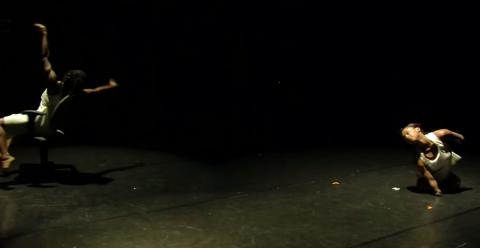September 14, 2014 - 17:18

I didn't upload the duet because it is longer than a minute, but you are welcome to watch it (linked here). The description of the video reads, "Kiera Brinkley, a quadruple amputee, and her sister Uriah Boyd perform SOAR, choreographed by Melissa St. Clair. Clips from the duet appear in a documentary of the same name that follows these two beautiful young women as their paths pull them in opposite directions." The documentary site includes even more information if anyone would like to follow up on that (linked here)

This image is a screencap from a duet, but I will talk about the duet and the screencap a little together. My comments don't necessitate watching the clip though. The image is of two black women dancing on a stage, black and not visible but for the spotlights on the two of them. Both of them are in motion - in the midst of a spin. Brinkley sits in the floor while Boyd sits in a chair that spins and is on wheels.
I screencapped this particular part of the duet because the video shows the two women essentially performing the same/similar acts, something that the whole duet features. Also while watching the whole duet, I noted that Boyd probably spends more time in the spinning chair, which is important in a way I discuss later...
To me, I saw the spinning chair almost like a mobility aid, while Brinkley is centered on the stage. Brinkley uses a mobility aid outside of her performance I believe, but she isn't featured this way for the majority of the show and thus not in this picture. I think it's almost like a role reversal. Boyd is aided to move more like her disabled sister. But also, to me it made me ask several questions about how I and others might percieve this. What does it mean to dance? Is Boyd "less" of a dancer for using a mobility aid on stage?
This duet made me think of Eli Clare and his mountain climbing. He described himself as having a supercrip within himself in a way that he can be displayed as "overcoming" his disability, and that a part of him wants to exceed expectations, but on the whole he thinks the idea should be killed. I think that this duet finds a similar sort of middle ground; the sisters are equally featured and it isn't about overcoming disability but for Brinkley and Boyd to both have similar ways of moving and dancing.
I think this is also important because it features two black women, and black women are an underrepresented and misunderstood population. In "Picturing People with Disabilities", Garland-Thomson touches on the importance of multicultural and varied representations of disabled people. Also discussed is authority and pose; Brinkley puts herself center stage in the spotlight and forces us to watch her dance and move just as her sister does. This particular pose I've screencapped involves a different spin than most dancers might be used to, but she is still put out on stage and is definitey graceful.
Now, I want to also briefly comment on something that happens later in the duet that I think is really important. This is an aside, I guess, to my posting since this doesn't focus on the screencap.
There is a point in the duet that Brinkley gets onto Boyd's back, and Boyd walks her to the chair and runs her around. The first time I watched it, that part seemed a little disconnected. The two of them aren't moving in time or in similar ways. But I think that is like a comment on how Brinkley does sometimes want/need help but that doesn't make her any less of a dancer or make it any less major as part of her life. It was just something that I thought was really cool and I probably could have made a completely separate post on just that one part as well.

Comments
Agreed - not a supercrip story
Submitted by abby rose on September 21, 2014 - 16:20 Permalink
I was really struck by the SOAR duet that rb.richx posted last week. I thought it was a truly impactful way to depict disability, particularly because Brinkley's impairment doesn't seem to impair her at all in the performance. As a quadruple-amputee, a great majority world would see Brinkely's impairment as unfortunate and seriously debilitating. However Brinkely's dance, which is a mirror image to that of her able-bodied sister, shows that these assumptions are unwarranted. I don't feel like this dance is a supercrip story because the general atmosphere is not that of "overcoming" disability but rather proving that disability is not synonymous with inability. Brinkely is not performing anything incredible, she is just showing to her audience that she is just as capable of dancing beautifully as her sister is. The duet also doesn't strike me as a supercrip story because although her impairment is visible, is it not portrayed as a spectacle either.
I'd also like to touch upon the moment that rb.richx mentioned in their post when the two sisters come together and Boyd carries her sister on her back. This moment strikes me as social commentary on the idea that if/when someone needs assistance, it does not detract from their presence or ability or humanness. It reminds me of the part in Exile and Pride when Clare discusses joining the regular ed kids in school and having to 'prove" that he was the same as them. His peers and family members and teachers did'nt really know how to receive him, so they acted as though he had no impairment at all and never asked him if he needed help with certain tasks. Clare conveys that he would have appreciated assistance at times, but it wouldn't have diminished his ability to be participate with his nondisabled peers. Like Clare, Brinkley demonstrates through dance that although she seeks assistance, she is still equal to an able-bodied person (in the duet's case, her sister) and should not be seen as any less capable.